Labor Market Update in Five Pictures
The strength of the labor market has perplexed investors, economists, and the Fed over the past year as unemployment remained at record lows and job openings at record highs despite an aggressive Fed tightening cycle. Though the labor market remains tight, employment data has begun to soften at the margins as pandemic distortions fade and labor demand and supply return to more normalized levels. The rebalancing of the labor market should help ease wage pressures and, in turn, temper core services inflation. In a recent speech, Fed Chair Powell highlighted that “core services other than housing may be the most important category for understanding the future evolution of core inflation.” Because wages make up the largest cost in core services excluding housing, the labor market holds the key to understanding inflation in this category and will drive the Fed outlook as well.
In this regard, we are providing a brief update on what we are seeing in the latest employment data. While current labor market data is strong and wage pressures are elevated, evidence is emerging that these pressures are easing, and further moderation lies ahead. Headlines in financial media on this topic are mixed in that some overstate labor market strength and some understate it. Our goal in this Investment Insights is to provide clarity on the dynamics in the space by highlighting key findings pertaining to the labor market in the five pictures that follow.
Layoffs and Pandemic Hiring
Key Takeaway: Despite layoff announcements recently highlighted in news headlines, the number of workers receiving pink slips is dwarfed by the number of employees hired over the past few years. Some companies that saw pandemic-fueled growth are now preparing for a slower growth environment.
Exhibit 1: Layoffs and Pandemic Hiring
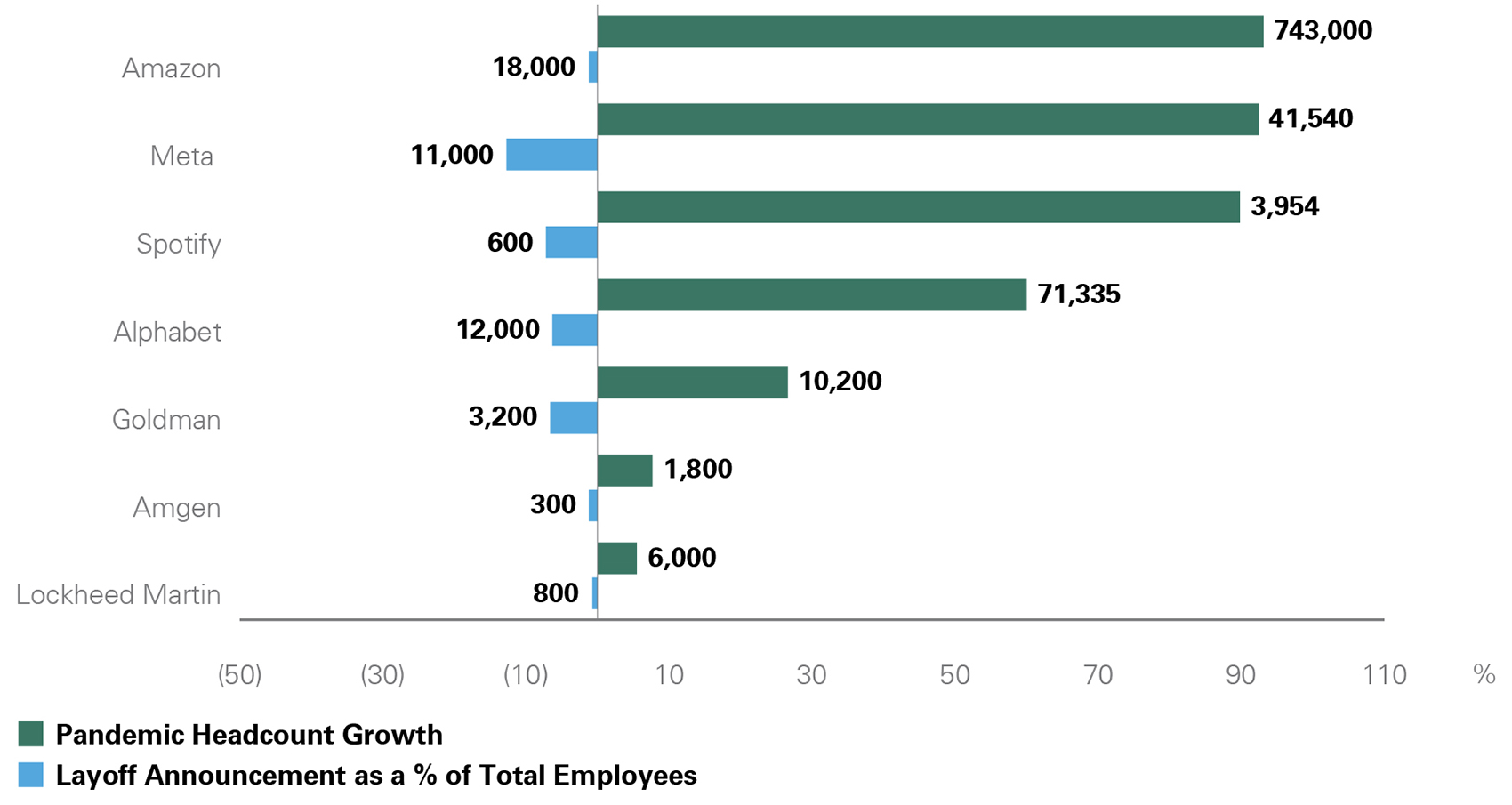
The exhibit contains a bar chart depicting the number of employees hired and laid off from the fourth quarter of 2019 to the fourth quarter of 2022 for Amazon, Meta, Spotify, Alphabet, Goldman Sachs, Amgen, and Lockheed Martin. Layoff announcements are as of the most recent layoff announcements recorded. Headcount growth and layoff announcements are represented as percentages of total employees, but the total numbers of employees hired or laid off are also provided. For all of the companies, the number of new hires vastly exceeded the number of layoffs in this period. Amazon, for instance, saw hires of 743,000 (93.1% growth) versus layoffs of 18,000 (1.2% of total headcount). Source: Bloomberg
Source: Bloomberg
Initial Jobless Claims and Unemployment Rate
Key Takeaway: Although layoff announcements are rising, initial jobless claims and unemployment remain low.
Exhibit 2: Initial Jobless Claims and Unemployment Rate
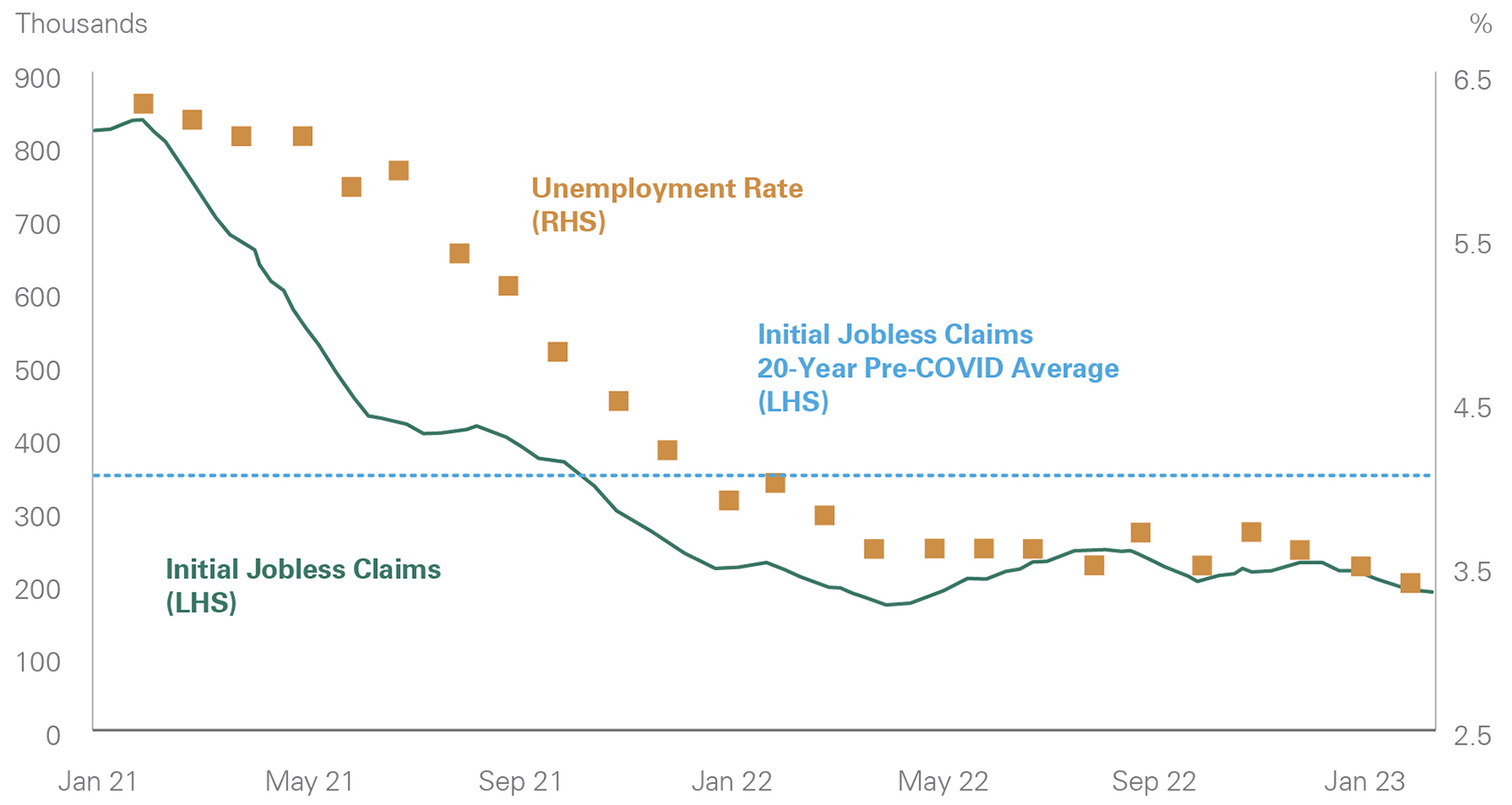
Exhibit 2 is a line graph depicting a steady decline in initial jobless claims and unemployment rate from January 2021 through January 2023, both falling below the Initial Jobless Claims 20-Year Pre-COVID Average in the fall of 2021 and continuing their descent since then.
Source: Bloomberg
U.S. Participation Rate and Missing Workers by Post-COVID Cohort
Key Takeaway: While labor force participation has improved recently, it remains below pre-pandemic levels as early retirees, aging demographics, and health and childcare challenges affect labor supply availability.
Exhibit 3: U.S. Participation Rate and Missing Workers by Post-COVID Cohort
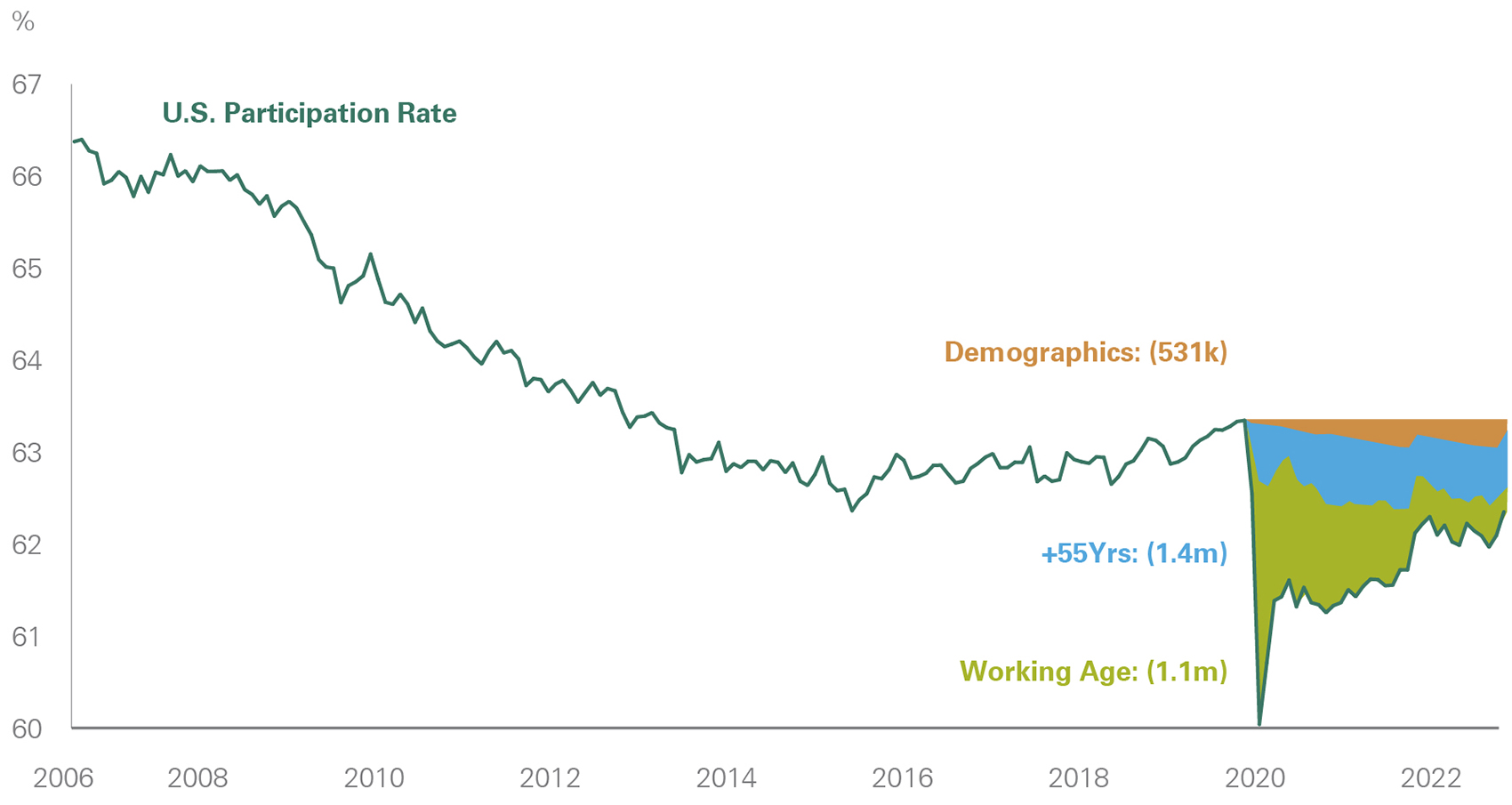
Exhibit 3 is a line graph depicting a gradual decline in the U.S. participation rate from 2006 until its dramatic decline in 2020, followed by gradual pickup through year end 2022. Also depicted are the portions of the population that left the workforce since the 2020 fall. Working age (age 16-55) workers accounted for 1.1 million of the decline in the number of works, workers older than 55 years accounted for 1.4 million of the decline, demographics (that is, the change that has occurred solely due to the aging of the population and not fluctuations of participation rates within specific age cohorts) accounted for 531,000 of the total number.
Source: Bureau of Labor Statistics
Number of Job Openings per Unemployed Person and Quits Rate
Key Takeaway: The labor market remains historically tight with nearly two job openings per each unemployed person and the quits rate elevated, though it has loosened at the margin from peak levels seen early last year. An increasingly challenging economic environment has likely caused some companies to reduce job openings.
Exhibit 4: Number of Job Openings per Unemployed Person and Quits Rate
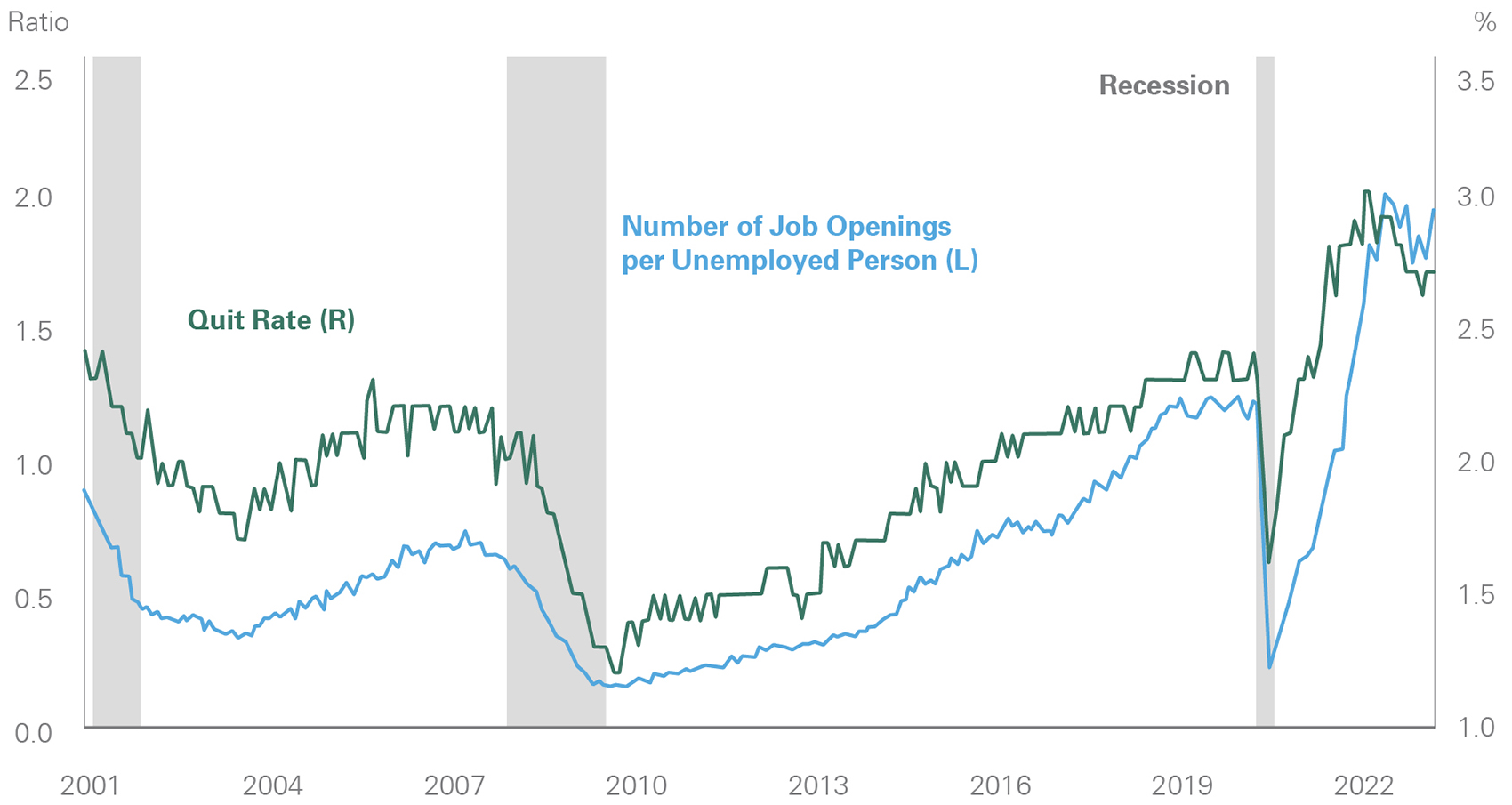
Exhibit 4 is a line graph depicting the number of quits each month from 2001 through year-end 2022. Quit rates declined during the recession in 2001, and then increased until the 2008-2009 financial crisis, when they declined dramatically. Following the crisis, quits increased steadily until the pandemic, when they dropped again in 2020. Quits picked up since then, although they have eased somewhat in recent months. The number of job openings per unemployed person have followed a similar pattern. Source: Bloomberg
Source: Bloomberg
Atlanta Fed Wage Growth Tracker
Key Takeaway: Wage growth remains elevated but has declined given labor market loosening and less pressure on cost-of-living adjustments as inflation moderates.
Exhibit 5: Atlanta Fed Wage Growth Tracker
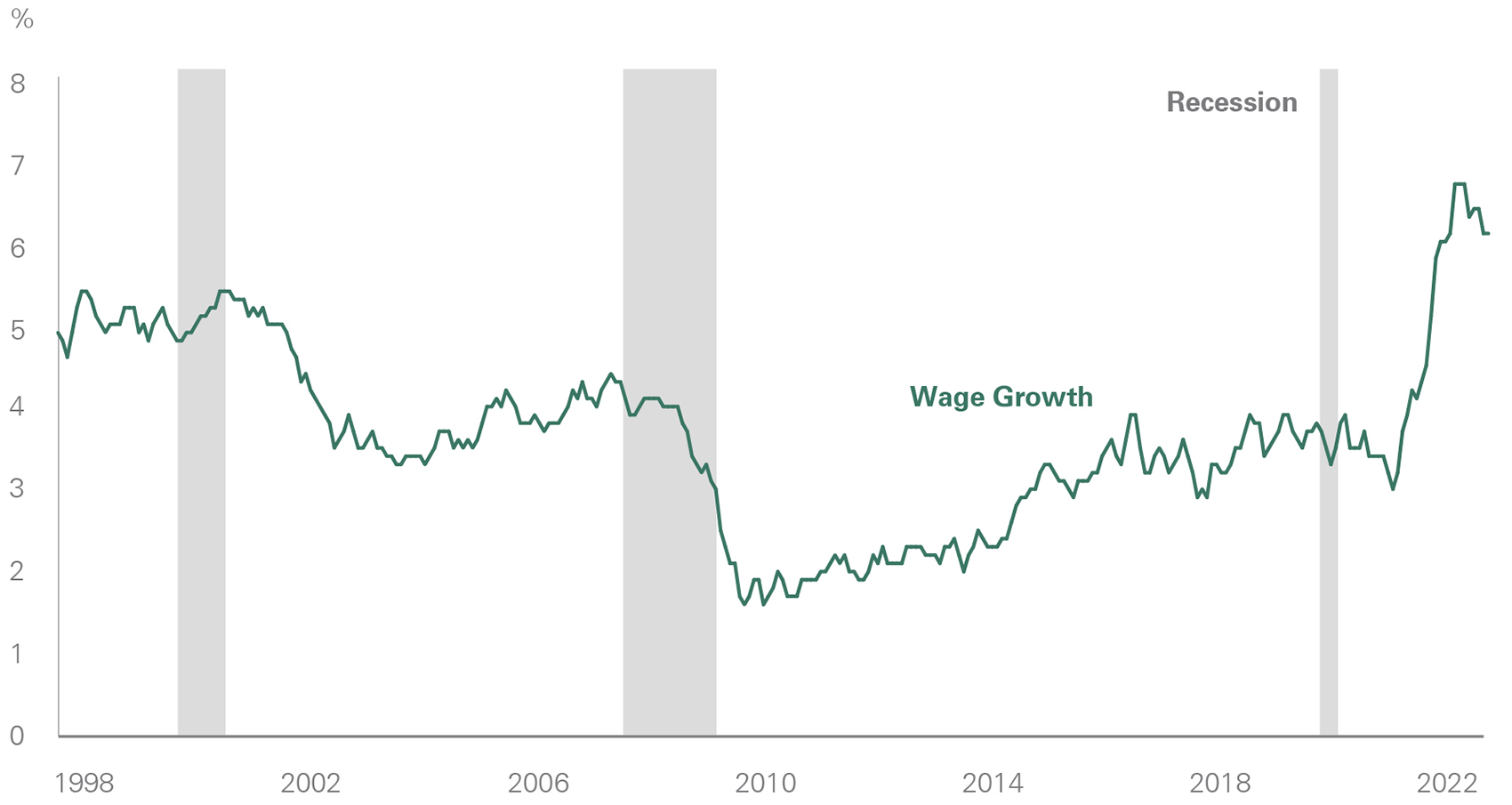
Exhibit 5 is a line graph that looks at the three-month moving average of median wage growth from 1998 through the end of January 2023, specifically the Atlanta Fed’s Wage Growth Tracker, which is a measure of the nominal wage growth of individuals. It is constructed using microdata from the Current Population Survey (CPS) and is the median percent change in the hourly wage of individuals observed 12 months apart. Wage growth declined dramatically in the 2008-2009 financial crisis, but then grew at a modest rate heading into the pandemic, and then picked up dramatically since then, rising well above the previous highs in 1998; it has declined modestly in recent months but remains elevated.
Source: Federal Reserve Bank of Atlanta
Past performance is no guarantee of future results. This material is provided for your general information. It does not take into account the particular investment objectives, financial situations, or needs of individual clients. This material has been prepared based on information that Bessemer Trust believes to be reliable, but Bessemer makes no representation or warranty with respect to the accuracy or completeness of such information. This presentation does not include a complete description of any portfolio mentioned herein and is not an offer to sell any securities. Investors should carefully consider the investment objectives, risks, charges, and expenses of each fund or portfolio before investing. Views expressed herein are current only as of the date indicated, and are subject to change without notice. Forecasts may not be realized due to a variety of factors, including changes in economic growth, corporate profitability, geopolitical conditions, and inflation. The mention of a particular security is not intended to represent a stock-specific or other investment recommendation, and our view of these holdings may change at any time based on stock price movements, new research conclusions, or changes in risk preference. Index information is included herein to show the general trend in the securities markets during the periods indicated and is not intended to imply that any referenced portfolio is similar to the indexes in either composition or volatility. Index returns are not an exact representation of any particular investment, as you cannot invest directly in an index.